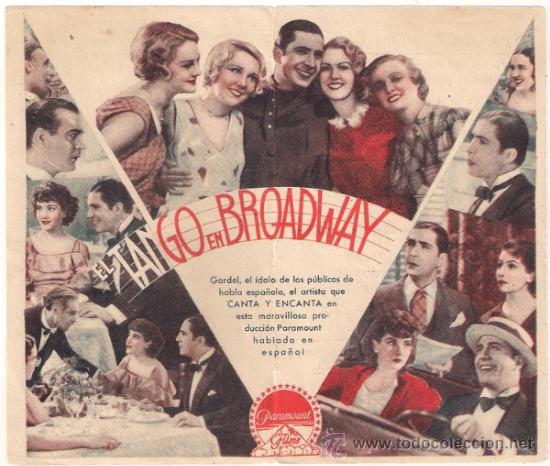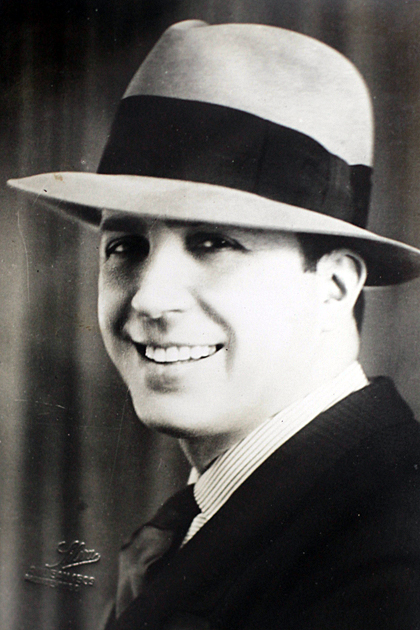I just watched a most delightful movie, El Tango en Broadway a musical directed by Louis J. Gasnier and released by Paramount Pictures in 1934. El Tango en Broadway is a Spanish-language production made in the U.S. for Spanish-speaking audiences, one of the relative few made in the 1930s that was an original story, not a Spanish remake of an English-speaking movie.

French-born director, Louis J. Gasnier started directing movies in 1905 and had steady work through the 1920s as a premier filmmaker. Gasnier had made a name for himself in the early years of cinema by directing such landmark serials as The Perils of Pauline (1914). After the movies started to talk, however, Gasnier’s popularity in the industry took a dive as he became one of the many silent players whose career was negatively affected by the advent of sound. Gasnier’s most famous 1930s movie is Reefer Madness (1936), but the productions he was called on to direct most frequently were either cheap, low-budget fare or Spanish-language remakes of English-speaking movies. With a few exceptions.
Carlos Gardel, best known as the premiere voice of Tango throughout Latin America and Europe by the time the 1930s came around, signed on to do movies for Paramount Pictures. Between 1933 and 1935 Gardel starred in a handful of features, which I believe were written and intended as Spanish-speaking original productions due to his international status and popularity. In other words, Carlos Gardel didn’t work on recycled remakes. Four of his movies, Esperame (1933), Melodia de Arrabal (1933), Cuesta Abajo (1934) and El Tango en Broadway (1934) were directed by Louis J. Gasnier.
I’ve heard Carlos Gardel recordings numerous times and had seen him in Norman Taurog’s The Big Broadcast of 1935 in which he briefly appears as a singer. Otherwise I was not familiar with his movies until I watched El Tango en Broadway. The title of the movie, “The Tango on Broadway” refers to Gardel himself since he was – and remains – the most popular interpreter of Tango in the world.

El Tango en Broadway is a screwball comedy about a rich, spoiled playboy (Gardel) who is suddenly forced to answer to his uncle who financially supports him. Gardel plays Alberto Bazán who is in NY managing his family’s Broadway production business. Or rather, that’s what he’s supposed to be doing with his time. What Alberto really spends his time on are dalliances – many of them. The message is clear upon the film’s opening when we see girls lying everywhere in Alberto’s house. The partying is part of Alberto’s lifestyle until the day his uncle, Indalecio Bazán (Jaime Devesa) shows up in the office from Argentina to check on the books and to meet his nephew’s fiancé. The problem is that the nephew has no intentions of ever getting married and knows nothing about books or ledgers.

The old man’s unplanned visit causes some confusion when Alberto’s girlfriend pretends to be his secretary and his secretary ends up having to pretend to be his girlfriend. It’s all very screwball. The grumpy old man is never the wiser, however, because a plan to soften him up, make the old man more of a playboy himself is put into play. The rather silly plot entertains one charming scene at a time thanks to a terrific cast that includes Trini Ramos and Blanca Vischer. Here is the rest of the cast of El Tango en Broadway. If you scroll down the list, by the way, you’ll see the great, film noir actor, Dan Duryea listed. Duryea made his screen debut in El Tango en Broadway by saying, “of course” when someone asks him for a light.
El Tango en Broadway is not a movie of substance, but rather an enjoyable romp not unlike so many English-speaking American films of the time. Oh, except for one thing – these Spanish-speaking movies were never really given the full care they deserved with even productions such as this one featuring an internationally famous talent lacking in certain details. As soon as you start watching this movie you’ll know what I mean as you hear certain secondary characters speaking and answering in English when spoken to in Spanish. In other words contract players were taken when available, it seems, regardless of whether they spoke Spanish or not. It’s makes for some fun this many years later, but I can’t imagine Spanish-speaking audiences the world over appreciated the lack of such obvious details. Although in this case they got plenty of Gardel and his singing, which is the best part of the movie and probably what they paid to see and hear. I was particularly charmed by “Golondrinas,” an absolutely beautiful Tango that has been recorded numerous times by incredible Latin American voices through the years.
If you’ve never had the chance to listen to Carlos Gardel sing do yourself the favor of looking him up and taking a listen. You won’t regret it and you’re welcome! Sadly Gardel’s life and career were cut short when he died in a plane crash in 1935.
◊
Click on the following image to learn more about #DePelicula

Sounds tremendous. Thanks for shedding some light.